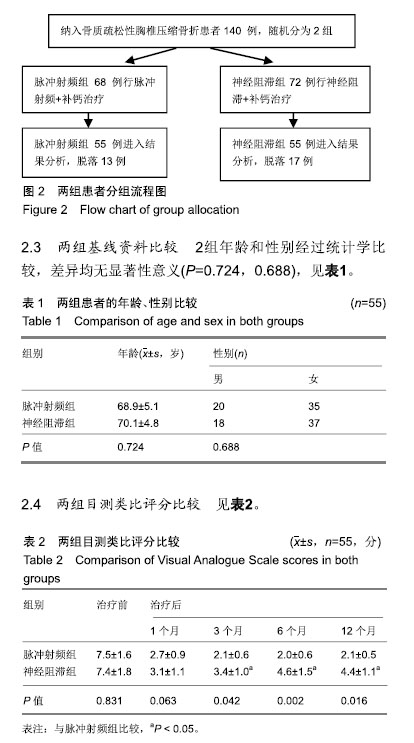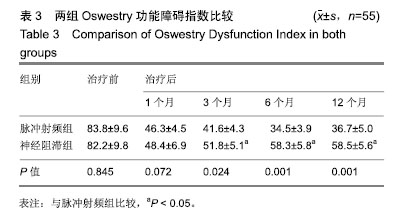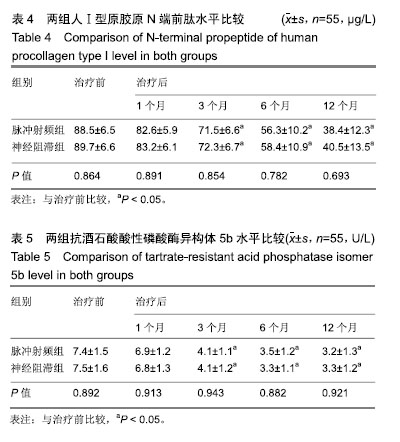中国组织工程研究 ›› 2019, Vol. 23 ›› Issue (28): 4491-4496.doi: 10.3969/j.issn.2095-4344.1455
• 脊柱植入物 spinal implant • 上一篇 下一篇
脉冲射频联合补钙治疗骨质疏松性椎体压缩骨折所致胸背痛
聂会勇1,张丹丹2,卜 岗1,王锁良1,吕 军3
- 西安交通大学第一附属医院,1疼痛科,2老年内一科,3临床研究中心,陕西省西安市 710061
Pulse radiofrequency combined with regular calcium supplement in the treatment of thoracic and back pain caused by osteoporotic vertebral compression fractures
Nie Huiyong1, Zhang Dandan2, Bu Gang1, Wang Suoliang1, Lü Jun3
- 1Department of Pain Management, 2First Department of Geriatrics, 3Clinical Research Center, First Affiliated Hospital of Xi’an Jiaotong University, Xi’an 710061, Shaanxi Province, China
摘要:
文章快速阅读:
.jpg)
文题释义:
脉冲射频:即在42 ℃的工作环境中,通过射频针周围的射频电流来阻断神经的疼痛信号传导。传统的观点认为射频电流是通过热效应致神经阻滞损伤而达到神经阻滞的治疗作用,而后来的研究证实阻滞神经的是射频电流而不是热效应。研究结果表明,42 ℃的脉冲射频电流可以起到与射频电流67 ℃同样的治疗效果。而在42 ℃的环境里,人体的组织损伤的概率明显下降,在保证治疗有效性的同时进一步降低并发症的发生。
骨质疏松性椎体压缩骨折所致腰背痛:临床过程中发现大量的老年患者出现不明原因的胸背痛,尤其是左侧胸背痛往往被当作心脏病进行检查和治疗,而经过胸椎的X射线检查后才知道是由于骨质疏松引起胸椎楔形变,也就是椎体压缩性骨折。该骨折可导致患者出现相应脊神经支配区域的疼痛,在临床诊断和治疗上专科性较强,一般的理疗、口服消炎止痛药物治疗效果不佳,往往需要综合的评估和专业的治疗才能获得满意的治疗效果。
摘要
背景:骨质疏松性椎体压缩骨折所致的胸背部疼痛在临床上很常见,而作为常规的治疗方法如口服消炎止痛药物、理疗、补钙和局部神经阻滞有一定的治疗效果,但往往停药不久疼痛又重复出现。而脉冲射频治疗骨质疏松性椎体压缩骨折所致的胸背部疼痛短期疗效显著,但是多数报道缺乏规范的骨质疏松治疗,远期效果欠佳。
目的:探讨脉冲射频联合指南补钙治疗骨质疏松性椎体压缩骨折引起的胸椎脊神经根性疼痛的效果。
方法:将收治的110例骨质疏松性椎体压缩骨折患者随机分为2组,每组55例。2组患者对治疗方案均知情同意,且得到医院伦理委员会批准。脉冲射频组对椎体压缩性骨折对应脊神经背根节行脉冲射频治疗;神经阻滞组对相应脊神经背根节行神经阻滞治疗;2组均应用碳酸钙D3、降钙素和唑来膦酸治疗骨质疏松症。随访治疗前和治疗后1,3,6,12个月,比较2组患者反映疗效的目测类比评分和Oswestry功能障碍指数;比较2组反映骨质疏松改善程度的人Ⅰ型原胶原N端前肽和抗酒石酸酸性磷酸酶异构体5 b水平。
结果与结论:①2组治疗后1,3,6,12个月的目测类比评分和Oswestry功能障碍指数较治疗前显著改善(P < 0.05);组间比较,在治疗后1个月,2组差异无显著性意义(P > 0.05),而治疗后3,6,12个月,脉冲射频组目测类比评分和Oswestry功能障碍指数改善情况优于神经阻滞组(P < 0.05);②人Ⅰ型原胶原N端前肽和抗酒石酸酸性磷酸酶异构体5b水平在治疗后1个月和治疗前比较,脉冲射频组、神经阻滞组差异均无显著性意义(P > 0.05);在治疗后3,6,12个月时2组人Ⅰ型原胶原N端前肽和抗酒石酸酸性磷酸酶异构体5b水平均较治疗前显著改善(P < 0.05);③提示脉冲射频联合指南补钙治疗骨质疏松性椎体压缩骨折所致胸背痛可明显改善患者疼痛程度和生活质量;从根本上改善骨质疏松症,远期效果满意。
ORCID:0000-0003-0922-7319(聂会勇)
中图分类号:




.jpg)
.jpg)